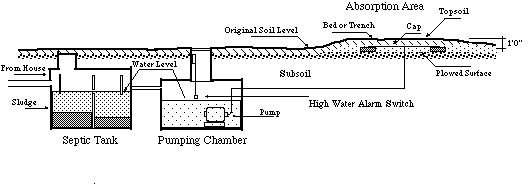Guidelines
1) Factors Affecting Approval of Greywater Systems
2) Types of Systems
3) System Capacity
It is important to recognize the definition of blackwater, and that blackwater can be generated by what would usually be considered greywater sources. For example, homes with babies or ill individuals can generate wastewater classifiable as blackwater out of clothes washers.
Wastewater systems that incorporate greywater irrigation should permit flexibility in response to occupant's wastewater patterns, seasonal variations in demand for irrigation, and weather. This system would entail a separate sewer or septic connected blackwater system that is linked to the greywater system for overflow and other backup purposes. However, the fact that blackwater can occasionally be generated by greywater sources is less of a concern in sub-surface systems than in above-ground systems.
1.0 Factors Affecting Approval of Greywater Systems
- Size of lot and topography (As a general rule of thumb, lot sizes well under one half an acre will need professional engineering. Steeper slopes - beyond 15% - may need more design and engineering work as well.)
- Subsoil texture (sandy and loamy soils are best)
- Subsoil structure (again, sandy and loamy soils are best)
- Soil depth
- Restrictive horizon factors (none within 36 inches of the ground surface)
- Soil drainage - internal characteristics and external factors such as flooding
- Soil permeability
- Flooding characteristics
2.0 Types of Systems
3.0 System Capacity
- The amount of greywater available for irrigation is obviously directly proportional to the amount of water used by a household. Water conserving fixtures and appliances produce a lower amount of wastewater as do smaller households. In a highly conserving home, 30 gallons per person per day of greywater is likely to be produced. This amount can vary according to individual usage patterns.
- If greywater is the primary source of irrigating water, a low water use landscape should be used. Year-round outputs of greywater through sub-surface systems make greywater irrigation ideal for maintaining evergreen trees and shrubs. The irrigation benefits of greywater should be integrated with the landscape design.
- The availability of greywater for irrigation on a square foot basis will vary according to the greywater system's area requirements. The system's area requirement is determined by the site's soil and slope characteristics discussed earlier. It is best to assume that some additional water from other sources than greywater will probably be needed on a seasonal basis.
To Next Section (Resources) | Back to Greywater Contents | Back to Sourcebook Contents
return to
Table of Contents
This document was adapted to HTML by Bill
Christensen, sysop and environmental editor of Texas InfiNet, an online
community for progressive information.
Sustainable Building Sourcebook web version copyright Sustainable
Sources 1994-1999.


 Figure 2
Figure 2 Figure 3
Figure 3